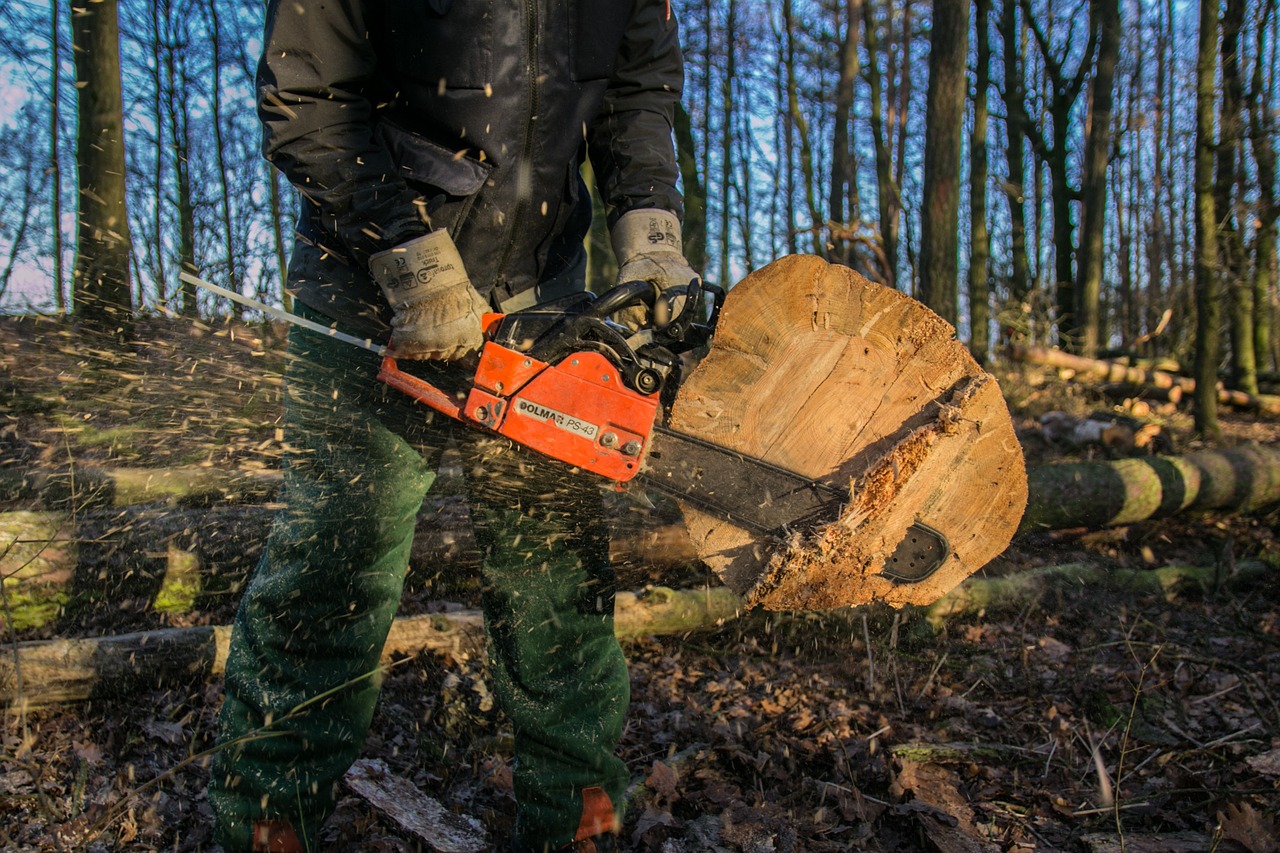When it comes to using a chainsaw, one of the most critical factors in achieving optimal performance and safety is choosing the right chainsaw chain. While the chainsaw itself is a powerful tool, the chain that wraps around its guide bar plays a pivotal role in determining how effectively it cuts through wood, branches, and other materials. In this comprehensive guide, we will explore the various types of chainsaw chains, their features, and how to select the perfect one for your specific needs.
The Significance of Choosing the Correct Chainsaw Chain
Selecting the appropriate chainsaw chain is crucial for achieving efficient cutting performance and ensuring safety while using a chainsaw. The type of chain you choose can significantly impact your work, affecting cutting speed, precision, and the overall quality of the cut. The right chainsaw chain can make your job easier, while the wrong one can lead to frustration, inefficiency, and even safety hazards.
Safety Precautions
Before we delve into the specifics of chainsaw chains, it’s essential to emphasize the importance of safety. Operating a chainsaw can be dangerous, and selecting the right chain is just one aspect of staying safe. Always follow safety guidelines, wear appropriate protective gear, and consider taking a chainsaw safety course if you are new to chainsaw operation.
2. Understanding Chainsaw Chains
The Anatomy of a Chainsaw Chain
Before we can make an informed choice about the best chainsaw chain for our needs, let’s understand the components that make up a typical chainsaw chain:
- Cutters: These are the tooth-like blades that do the cutting. They are attached to the chain at specific intervals.
- Drive Links: Drive links are the links that sit in the guide bar’s groove and engage with the sprocket. They transfer power from the engine to the chain.
- Depth Gauges: These are the small protrusions in front of each cutter that control how deep the cutter bites into the wood.
- Tie Straps: These are the links that connect the cutters to the drive links, forming a continuous loop.
Types of Chainsaw Chains
Chainsaw chains come in various types, each designed for specific tasks and cutting conditions. Here are the primary types of chainsaw chains:
- Full-Chisel Chains: Known for their sharp teeth and aggressive cutting style, full-chisel chains are excellent for clean and fast cuts but require more frequent sharpening.
- Semi-Chisel Chains: These chains are more forgiving and maintain their sharpness longer than full-chisel chains. They are a versatile choice for various cutting tasks.
- Low-Profile Chains: Low-profile chains have a reduced kickback tendency, making them a safer option for inexperienced users. They are often found on homeowner-grade chainsaws.
- Safety Chains: Designed with additional safety features, safety chains reduce the risk of kickback and are often used by professionals in hazardous conditions.
- Carbide Chains: Carbide chains are incredibly durable and excel in cutting through tough materials like concrete and metal.
- Ripping Chains: Ripping chains are optimized for cutting along the grain of the wood, making them ideal for milling lumber.
3. Choosing the Right Chainsaw Chain
Essential Considerations
Selecting the right chainsaw chain involves considering several critical factors:
- Cutting Needs: What type of cutting will you be doing most often? Are you felling trees, pruning branches, or cutting firewood? Your specific tasks will dictate the type of chain you need.
- Chainsaw Size: The size and power of your chainsaw play a significant role in chain selection. Larger chainsaws can handle longer and more aggressive chains.
- Experience Level: Your experience with chainsaws matters. Novice users may prefer chains that are more forgiving and safer.
- Wood Type: Different wood types have varying levels of hardness. Softwoods like pine require different chains than hardwoods like oak.
- Maintenance Preferences: Consider how much time and effort you are willing to invest in chain maintenance. Some chains require more frequent sharpening than others.
Key Features of Chainsaw Chains
When evaluating chainsaw chains, keep an eye out for the following features:
- Gauge: The gauge refers to the thickness of the drive links. Ensure the chain’s gauge matches your chainsaw’s guide bar.
- Pitch: Pitch is the distance between the drive links, and it must also match your chainsaw’s sprocket.
- Chain Length: The chain’s length is essential. A chain that is too long or too short won’t fit your chainsaw properly.
- Cutter Tooth Design: Pay attention to the shape and style of the cutter teeth, as this impacts cutting performance.
- Anti-Kickback Features: Some chains come with anti-kickback features designed to reduce the risk of sudden and dangerous kickback incidents.
Matching the Chain to Your Chainsaw
To ensure compatibility between your chainsaw and the chain you select, consult your chainsaw’s manual. It will provide specifications for the recommended chain gauge, pitch, and length. Using the wrong chain can lead to poor performance, excessive wear on the chain and guide bar, and even safety issues.
Notable Chainsaw Chain Manufacturers
Several reputable chainsaw chain manufacturers offer a wide range of options to choose from. Some well-known brands include Oregon, STIHL, Husqvarna, and Carlton. Researching these brands and their product lines can help you find the right chain for your needs.
4. Different Types of Chainsaw Chains
Now that you have a better understanding of the factors to consider when choosing a chainsaw chain, let’s delve deeper into the different types available:
Full-Chisel Chains
- Best For: Professional loggers, experienced users.
- Pros: Fast cutting, efficient, excellent for hardwoods.
- Cons: Requires frequent sharpening, more prone to kickback.
- Recommended For: Felling trees, cutting large logs, professional use.
Semi-Chisel Chains
- Best For: Versatile users, general homeowners.
- Pros: Durable, forgiving, maintains sharpness longer.
- Cons: Slightly slower than full-chisel chains.
- Recommended For: Pruning, firewood cutting, general use.
Low-Profile Chains
- Best For: Occasional and novice users.
- Pros: Reduced kickback risk, easy to handle.
- Cons: Lower cutting efficiency.
- Recommended For: Light pruning, occasional use, beginners.
Safety Chains
- Best For: Professional loggers in high-risk situations.
- Pros: Enhanced safety features, reduced kickback.
- Cons: Slightly slower than other chains.
- Recommended For: Hazardous conditions, professional use.
Carbide Chains
- Best For: Specialized tasks, concrete cutting, metal cutting.
- Pros: Extremely durable, maintains sharpness in harsh conditions.
- Cons: Expensive, not suitable for woodcutting.
- Recommended For: Cutting concrete, metal, masonry.
Ripping Chains
- Best For: Lumber milling, woodworking.
- Pros: Efficient at cutting along the grain, less strain on the chainsaw.
- Cons: Not suitable for cross-cutting or other tasks.
- Recommended For: Milling lumber, creating planks.
5. Maintenance and Care
Proper maintenance and care of your chainsaw chain are essential for extending its lifespan and ensuring safe and efficient operation. Here are some maintenance tips:
Maintaining Sharpness
A sharp chain is crucial for efficient cutting. Dull chains not only slow down your work but also increase the risk of kickback. Regularly sharpen your chain using a file or a chainsaw sharpener. Follow the manufacturer’s recommendations for the correct sharpening angles and techniques.
Chain Tensioning
Maintaining the proper chain tension is crucial for safe operation. A loose chain can derail or even come off the guide bar, while an overly tight chain can cause excessive wear. Check and adjust the chain tension regularly, following your chainsaw’s manual for guidance.
Cleaning and Lubrication
Keep your chain clean and well-lubricated. Use the appropriate chain oil recommended by your chainsaw manufacturer. Regularly inspect the oil reservoir and refill it as needed to ensure proper lubrication during operation.
Replacing the Chainsaw Chain
No chainsaw chain lasts forever. When you notice signs of wear, such as reduced cutting performance or visible damage, it’s time to replace the chain. Always replace it with a chain that matches your chainsaw’s specifications.
6. Safety Guidelines
Appropriate Safety Gear
Before operating a chainsaw, ensure you are wearing the following safety gear:
- Helmet with face shield or safety goggles: Protect your eyes and face from flying debris.
- Hearing protection: Chainsaws are loud and can cause hearing damage over time.
- Chainsaw chaps or pants: These specially designed pants or chaps can protect your legs from accidental cuts.
- Steel-toed boots: Ensure your feet are protected from falling objects and accidental contact with the chainsaw chain.
- Gloves: Keep your hands safe from blisters, cuts, and vibrations.
- Hard hat: Protect your head from falling branches and debris.
Safe Operation of Chainsaws
- Read the manual: Familiarize yourself with your chainsaw’s manual, including safety instructions.
- Inspect the chainsaw: Before each use, check for any loose parts, damage, or issues.
- Choose the right chain: Follow the guidelines in this guide to select the appropriate chainsaw chain for your task.
- Start the chainsaw safely: Follow the recommended starting procedures in your manual.
- Maintain a secure grip: Hold the chainsaw firmly with both hands.
- Beware of kickback: Be aware of the potential for kickback and take precautions to prevent it.
- Cut at waist height or below: Maintain control of the chainsaw by cutting at or below waist height.
- Clear the work area: Remove obstacles and debris from the cutting area.
- Never work alone: Have someone nearby in case of an emergency.
- Shut off the chainsaw when not in use: Always turn off the chainsaw when setting it down or moving to a new location.
7. Conclusion
Selecting the right chainsaw chain is a critical decision for anyone who works with a chainsaw. The choice you make can significantly impact your efficiency, safety, and the quality of your work. By considering factors such as your cutting needs, chainsaw size, and experience level, you can make an informed decision and select the perfect chainsaw chain for your specific requirements.
Remember that safety should always be your top priority when operating a chainsaw. By following the safety tips outlined in this guide and maintaining your chainsaw and chain properly, you can ensure a safer and more productive chainsaw experience. So, whether you’re a professional logger, an arborist, or a homeowner, make the right choice and find the perfect chainsaw chain to suit your needs. Happy cutting!










